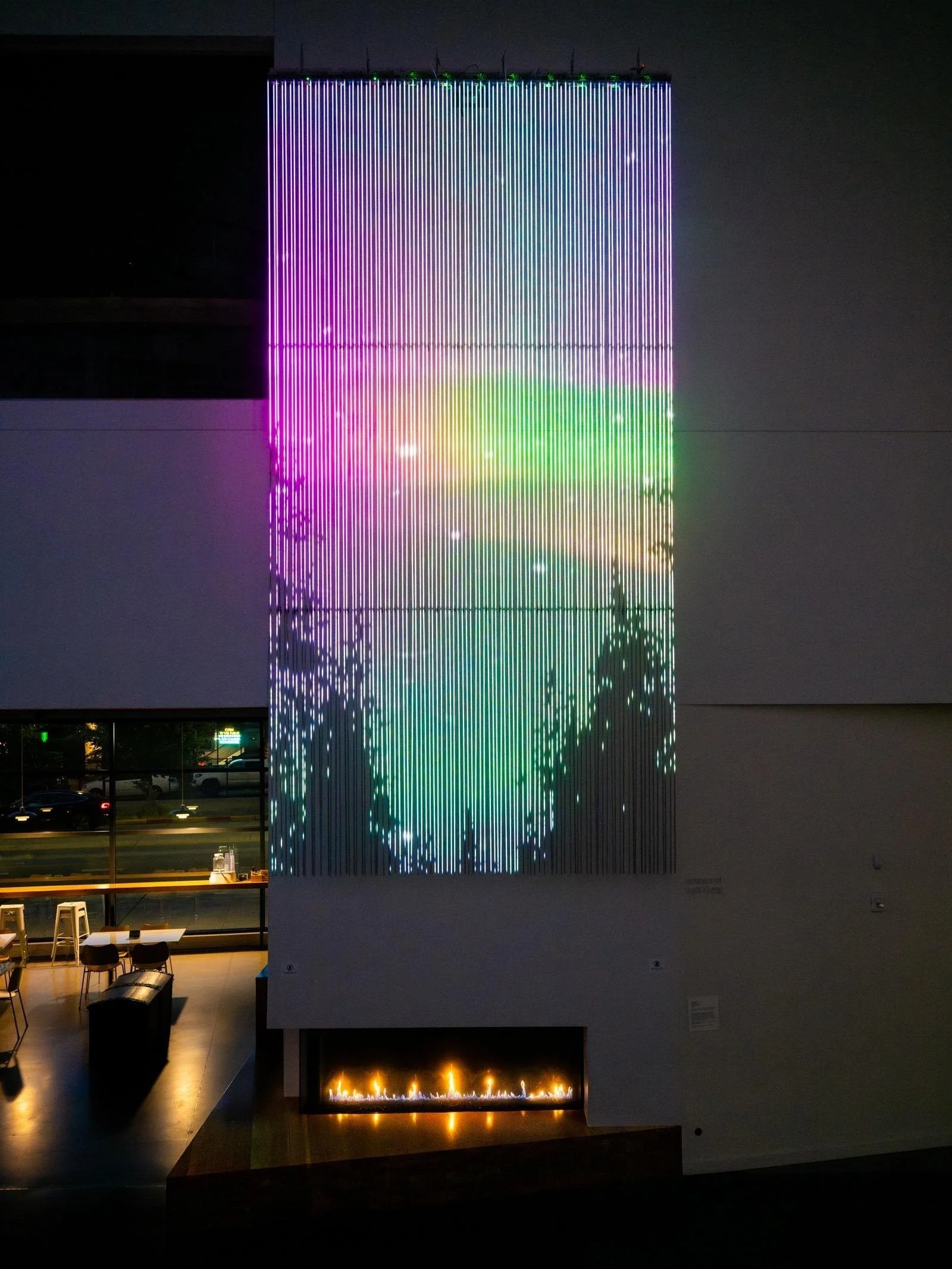Missed the Northern Lights in 2024? Check Out Project Aurora
A year marked by breathtaking Puget Sound aurora borealis visits may be behind us, but the work of Ballard-based multimedia artist Ginny Ruffner immortalizes the phenomenon with Project Aurora—a newly permanent exhibit at the National Nordic Museum.
The medium of LED lights guided by programmed microprocessors towers over the entrance lobby of the museum thanks to support from the Kongsgaard Goldman Family. Ruffner created Project Aurora in collaboration with video game industry professionals Ed Fries (“maker”) and Dr. Wanda Gregory (“ideator”).
“Creating a representation of the most elusive phenomenon required a lot of equally complex technical expertise,” said Ruffner in a press release. “My hope is that the aurora borealis’ incredible beauty (created by just wind and atoms) inspires humans to be aware of the beauty of the natural world and their impact on that beauty through their individual impact on the physical world.”
Project Aurora hangs like a curtain of 34,500 suspended LED lights that’s 20’ high and 10’ wide. The display packs a peak brightness of 350,000 lumens which is equivalent to 225 household 100W bulbs. A series of microprocessors update and randomize the light array as dictated by programming reportedly aided by artificial intelligence (AI).
(I only say “reportedly” because what is AI in this era of tech hype, really? One could randomize these lights without AI and I’ve not rallied a panel of experts to bust open Project Aurora and determine if bona fide AI is whirring around in there or not. But enough quibbling.)
Project Aurora hanging in the National Nordic Museum
Jim Bennett
The concept is to replicate the brightness, color, and shimmering unpredictable patterns of the natural aurora. Project Aurora completely changes its appearance over 20-second cycles and was built to never repeat the exact same pattern. Every glance at the piece should be one-of-a-kind. The ephemeral and beautiful nature of both the real-world aurora and perhaps life itself is evoked. Every transitory bright green tendril is not unlike a snapshot of the life experience; random seeming while unfolding as per mysterious cosmic structure. The second-to-second moments feel common yet are also completely unique and non-repeating. Project Aurora is mounted above eye-level, forcing the observer to gaze upwards like the real-world experience.
Atlanta-native Ruffner was originally a University of Georgia trained painter. Her glass sculptures have reportedly been held in more than 50 collections globally and her work has been featured in hundreds of group and solo exhibitions. Ruffner’s notable recent projects involve the use of augmented reality (AR). Reforestation of the Imagination is an example of her AR work and was featured at The Smithsonian Museum’s Renwick Gallery in 2019-2020. For those curious about Ruffner’s art, she’s the subject of a 2010 documentary A Not So Still Life, the Ginny Ruffner Story. She’s also the author of two books that accompanied her previous shows.
“I think many people perceive me as a glass artist,” Ruffner said in an interview that’s part of the Nordic Museum installation. “It's amusing to me because glass is perhaps maybe 25 percent of what I do. I do many other things, predominantly tech art, augmented reality, AI. It's really cool because two things: A) It doesn't break, and B) You can paint all day and never get dirty.”
Her collaborators for Project Aurora have impressive resumes as well. Ed Fries was formerly vice president of Microsoft and leader of the team that developed Xbox. Dr. Wanda Gregory is a scholar of gaming and lecturer at the University of Washington, Bothell. Fries and Dr. Gregory were undoubtedly instrumental in the technical aspects of Project Aurora’s hardware and programming. The collaboration underscores the emphasis on the intersection of nature and technology.
“Project Aurora gives us the incredible opportunity to witness the remarkable spectacle of the Northern lights through cutting-edge technology, while celebrating the vision of a world-renowned artist in our own neighborhood,” said Chief Curator of the National Nordic Museum Leslie Anderson.
“I created Project Aurora because I wanted to try another form of tech art and I wanted to call attention to the wonderful phenomenon that is the aurora borealis,” Ruffner continues in her interview. “You cannot own it, you can't possess it, and hopefully you can't mess it up and it is an enigma. It's programmed with videos of the actual aurora that are manipulated slightly to continue changing and the programmer was the brilliant Ed Fries.”
Project Aurora’s large dimensions and unabashed, bold colors seem to imply a statement that nature and technology, so often at odds, can harmonize. Minutes easily slip past when one gazes at the expansive display. A person could, however, have another reaction. Project Aurora, no matter how impressive, is not the real thing. Are we viewing a flawless synthesis of nature and technology, or is the technology pulling off a sort of digital hallucination that’s akin to experiencing the world through YouTube videos? Instead of a sense of peace, one can feel unease. Perhaps technology’s relationship to nature is more insidious than the creators intended.
“One of the greatest things people are afraid of is the unknown because it's new, it's unknown,” Ruffner’s interview touches on widely held negative attitudes about technologies like AI. “And I'm not afraid of the unknown. Yet another thing to explore, yet another thing to be curious about. I mean, many people are afraid of their own brain because it is unknown, but I find it a really friendly place and you never know what you'll find there.”

